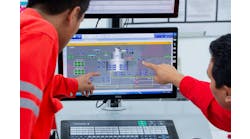I was at the gym a few weeks back, and—what do you know?—I saw it. “It” was a lengthy advertisement for a machine predictive analysis solution that was cloud-based.
I said to myself, “That has to be from GE,” and it was. I attended a briefing on GE’s Equipment Insight, a product and service developed by the Predictivity (or Predix) division. Aptly named. Effectively, it is a remote asset monitoring solution—a centrally managed solution. There were fewer than 12 of us in the room, so it was an intimate group. Saul Yeaton, COO for the Insight solution, was our tour guide.
Of course, the intent of the solution is to tie all of those IIoT devices into a network and have them talk their language and have the words and sentences stored in the cloud for monitoring and analysis. The intent of the briefing was to get peeps to sign up for a “risk-free” 90-day trial.
This is how it works: there is a field-agent device that resides in the plant. It can operate over Wi-Fi or 3G. The 3G option allows the device to circumvent the plant level LAN if that is an issue. This device uses OPC to communicate to floor devices, and there isn’t any cost associated with multiple OPC drivers.
The field agent is a definite purpose device that can access upward of 300 KPIs, which are to be interpreted as tags. This device grabs the data at a specified time frame—note that less than a second isn’t available—and stores the data in its buffer; it then forwards the data to the Insight server in the cloud.
Also read: Can I monitor and program using the same remote-access hardware or software?
If communications is interrupted, the buffering is local so no data is lost. Once the data that the customer wants to monitor has been identified, the support staff configures the field-agent tables for data distribution to the cloud. Remember, I said it was a managed service.
Once the agent is configured, it is attached to your floor network (wired) and effectively can connect to four different subnets. The data access portion is completed.
The data is transmitted via an encrypted packet to the private servers at GE’s Insight cloud. There, the data is stored and separated into various reporting groups, which would be used for future analytics. The impression I had from the questions asked was that the reporting and resulting insight were created by GE, and not readily configurable as such by the user.
It’s kind of like they own your data, and they own the process. You can get additional reports done since the core technology at the cloud location is Proficy, but it is GE’s cloud. Having write access to anything isn’t allowed, as such. It was stated that some requests and changes were part of the monthly solution fee, but some would be extra costs since the GE team would have to makes the changes.
There is no configuration allowed on the field agent, since write access can only be done by GE, so it is effectively the manager of the solution.
This can be very attractive to some customers. It’s an expense per month; responsibility is in someone else's hands; and the resulting data and reports help you, the customer, in solving issues, without creating new ones. But does it takes us back? We are putting our trust and future in the hands of a wizard in the cloud. But, again, that may be attractive to some.
The presentation also talked about interfaces, which can be multiple devices over the Internet, and having access anywhere. It really can take away some of the responsibility of the local SCADA nodes and servers. The OEM market was also mentioned, in that an OEM can provide the service for its machines and processes and use it as a revenue stream—an interesting hook.
There are other remote asset monitoring solutions out there, and attempting you to commit to a solution now is concerning to me. You become an active audience at that point.
The service looks good, and the ad that I saw looked like the control room is very sophisticated. Call me a skeptic, but the ad was developed to give you that “just leave it all to me” feeling. I like being more independent.
There will be more “service and solution” providers such as MTell and FreePoint Technologies emerging into this space. Choose wisely.
Homepage image courtesy of iprostocks at FreeDigitalPhotos.net






